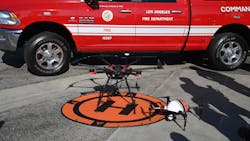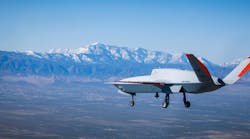WASHINGTON — Drones for fighting wildfires are taking off in many states, but federal agencies are caught up in regulation and procurement challenges. Lawmakers in Congress are set on changing that to advance unmanned aircraft in monitoring and even mitigating blazes in the forests.
Both the House and the Senate included language in their Federal Aviation Administration reauthorization bills that would prod the agency to promulgate plans to expand the use of uncrewed aerial systems, more commonly known as drones, as well as open up federal lands for testing efforts — provisions that drone advocates say will better inform wildland firefighters of conditions without risking boots on the ground in volatile areas.
“Representing a Western district, I’ve heard from wildland firefighters and local governments firsthand about the need to better coordinate all aerial aspects of wildfire detection, prevention and suppression,” said Rep. Dina Titus, D-Nev., who worked to include drone provisions in the House bill. “They have told me that the evolving technology of drones and other unmanned systems has already shown promise in firefighting, which is why I pushed language in this year’s FAA legislation to make it easier for them to operate safely and more effectively.”
The language in the House FAA reauthorization bill is taken from bills introduced by Titus and Transportation and Infrastructure Aviation Subcommittee Chair Garret Graves, R-La. The measure from Graves and Titus would have the FAA allow commercial drones to be used with “beyond visual line of sight operations,” or BVLOS. Titus’ bill would direct the FAA to work with the Forest Service to designate public areas where drones can be used for wildfire efforts without the operator being in the visual line of sight.
The Senate bill also addresses beyond visual line of sight operations by directing the FAA to promulgate a rule-making to enable commercial BVLOS operations as well as designate drone test ranges for research priorities like BVLOS and nighttime operations.
Drones in states
The provisions touch on a number of hurdles that the drone industry and aeronautical experts have been urging the federal government to fix, including current rules requiring operators to have their drones in sight at all times, limits on drones flying over federal lands and lack of test ranges for developing the technology.
And there are even more issues outside of the scope of the FAA reauthorization bill that advocates are hoping Congress and agencies will address, such as countering Chinese dominance in the drone industry and organizing how agencies coordinate with each other to regulate the complicated intersections of drones and wildland fires.
Many states and local wildland firefighting units have already embraced drones to capture thermal images of the landscape and even administer prescribed burns in remote areas. Justin Jager, the chair of the National Wildfire Coordinating Group’s Interagency Fire Unmanned Aircraft Systems Subcommittee — a state, federal and local interagency coalition formed to provide guidance on drones and wildfires — said that “you’d be surprised” at how many states have wildfire drone programs.
“One of our members is the National Association of State Foresters, which covers basically every state,” Jager said. “Some of the bigger programs might be California, Colorado, Oregon, Washington, but you also have West Virginia and Florida and North Carolina. They have these big drone programs too.”
The programs are still relatively new and vary in size from state to locality to agency. Matt Sloane, CEO and founder of SkyFire Consulting, a drone program consulting firm, estimated that of the roughly 40,000 police, firefighting and other local emergency response agencies in the United States, some 3,000 or so are using drones.
But the state and local programs have made clear what federal agencies and Congress need to address to scale up drone operations for wildland fires. For example, the current line of sight rules greatly limit wildland firefighters’ ability to use uncrewed aircraft, Sloane said.
In some cases, the rule made in the name of safety does “more harm than good” for wildfire emergency response, he added.
“If I’m in downtown L.A. and I’m flying a drone 2 miles away, that could potentially be a problem,” Sloane said. “If I’m out in the middle of the desert, and all we’ve got out there is wildfire response efforts, then we know where everybody is.”
A Democratic committee staffer explained that the House bill language is meant to mobilize the FAA to target areas of higher potential for wildfires with drones operating beyond the visual line of sight. The FAA wrote in a March 2022 report that its current regulations “do not enable the domestic (drone) beyond visual line-of-sight industry to scale and achieve meaningful results” and “do not reflect the competencies needed to safely operate highly automated UAS, which hinders the ability to expand UAS BVLOS operations.”
The language also would direct the FAA to consider using drones for aerial wildfire mitigation and suppression, a detail that Sloane explained could open up potential for drones to be used for fuels management and other wildfire prevention efforts, and coordinate with other agencies.
John Dabiri, a member of the Biden administration’s President’s Council of Advisors on Science and Technology, or PCAST, who is an aeronautical engineer and professor at the California Institute of Technology, said the test range language in the Senate bill is also a boon for wildfire drone programs because it would provide opportunities to test operations in weather conditions specific to certain regions.
“They would have permission to be able to fly and operate with the wind conditions, which can be really challenging around one of these fires because they’re creating their own weather,” he said. “Until we have some of these test ranges up and running, there’s going to be this persistent question of whether these technologies that sound nice on paper, are they more than just an interesting lab gadget or can they really save lives on the front line?”
Beyond FAA
Coordination is another obstacle that the bills aim to address, but one that the FAA and other agencies could struggle with, said former NASA astronaut Kathryn Sullivan, who is also a PCAST member. PCAST submitted recommendations on modernizing wildland firefighting to the White House in February, determining that “no single entity has successfully marshaled the diverse expertise needed across multiple agencies to address” wildfire drone technologies.
Sullivan said in an interview that the culture among federal firefighting forces is “very much still boots on the ground, old-school style” wildfire fighting techniques, and it’s going to take a “mind shift” for agencies like the Forest Service, FAA and Interior Department to lean into technologies like drones. NASA, she said, might have an easier time, although the bills do not specifically require FAA to work with NASA.
“NASA has much more experience designing and operating with special-purpose airspace. The FAA airspace regime is very good, it’s very effective, but it’s set for a pretty stable, fairly routine pattern of operations,” Sullivan said. “Firefighting is anything but that.”
There’s also concern over whether the federal government will be able to keep up with regulating and procuring the evolving technology, especially as the U.S. continues to shift the drone manufacturing industry away from China and toward the United States.
The Interior Department in 2020 grounded all of its nonemergency drones over concerns that they would compromise U.S. national security interests. Although Sloane agrees the United States should move away from Chinese drones, he said the drones that have been cleared for use are “twice the price and not as capable as the Chinese drones.”
“I know that from being on the inside of one, the Chinese government is subsidizing these companies to make bigger drones, and they have 10,000 engineers working on this,” he said. “And our companies are barely struggling to keep their heads above water because while we all agree that it would be better to have American drones, there’s no infrastructure for that.”
The House Transportation and Infrastructure Committee approved its FAA bill in June, and it’s expected to go to the House floor in July. The Senate Commerce, Science and Transportation Committee has yet to mark up its FAA bill.
___
©2023 CQ-Roll Call, Inc., All Rights Reserved. Visit cqrollcall.com. Distributed by Tribune Content Agency, LLC.

